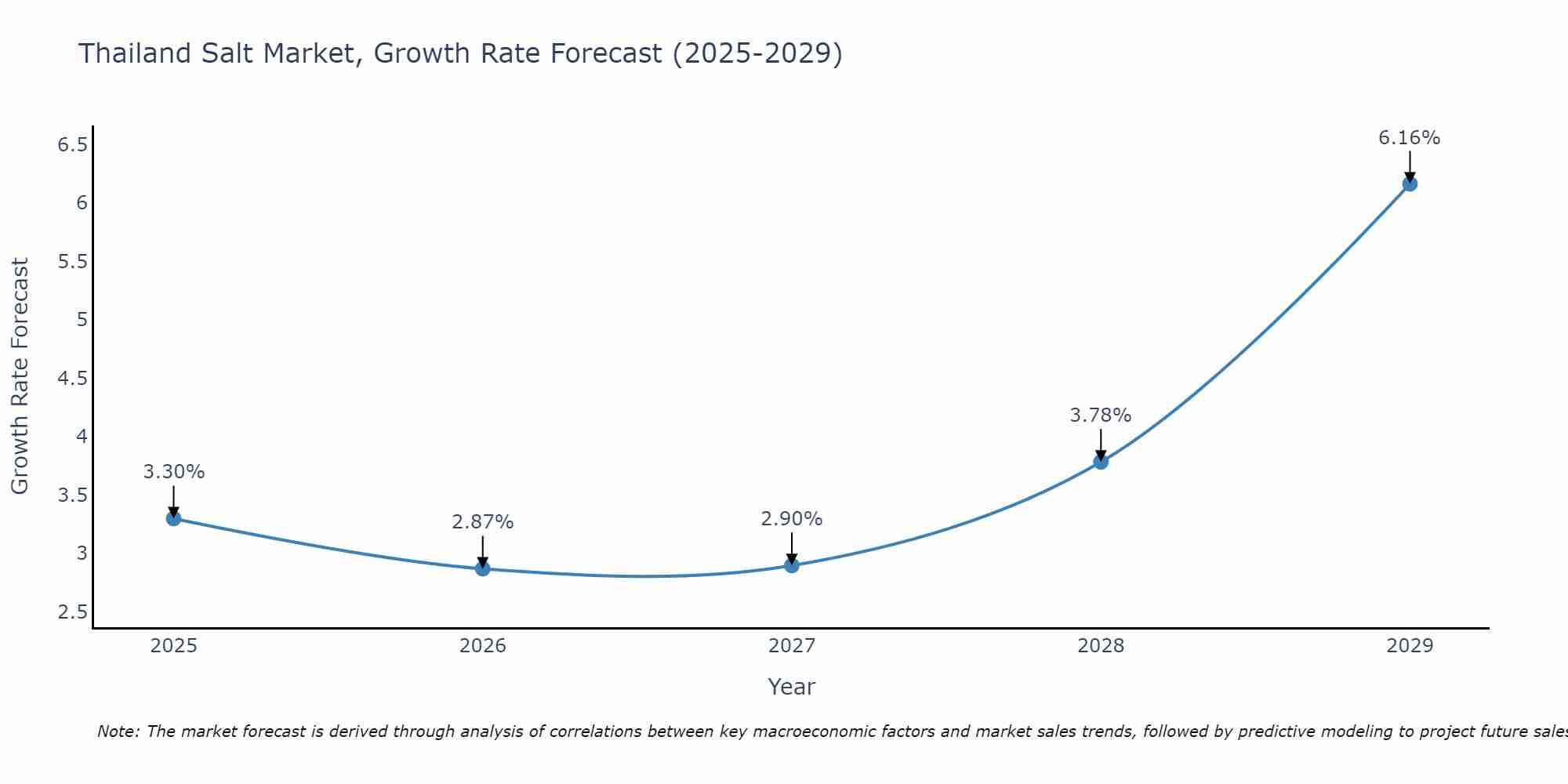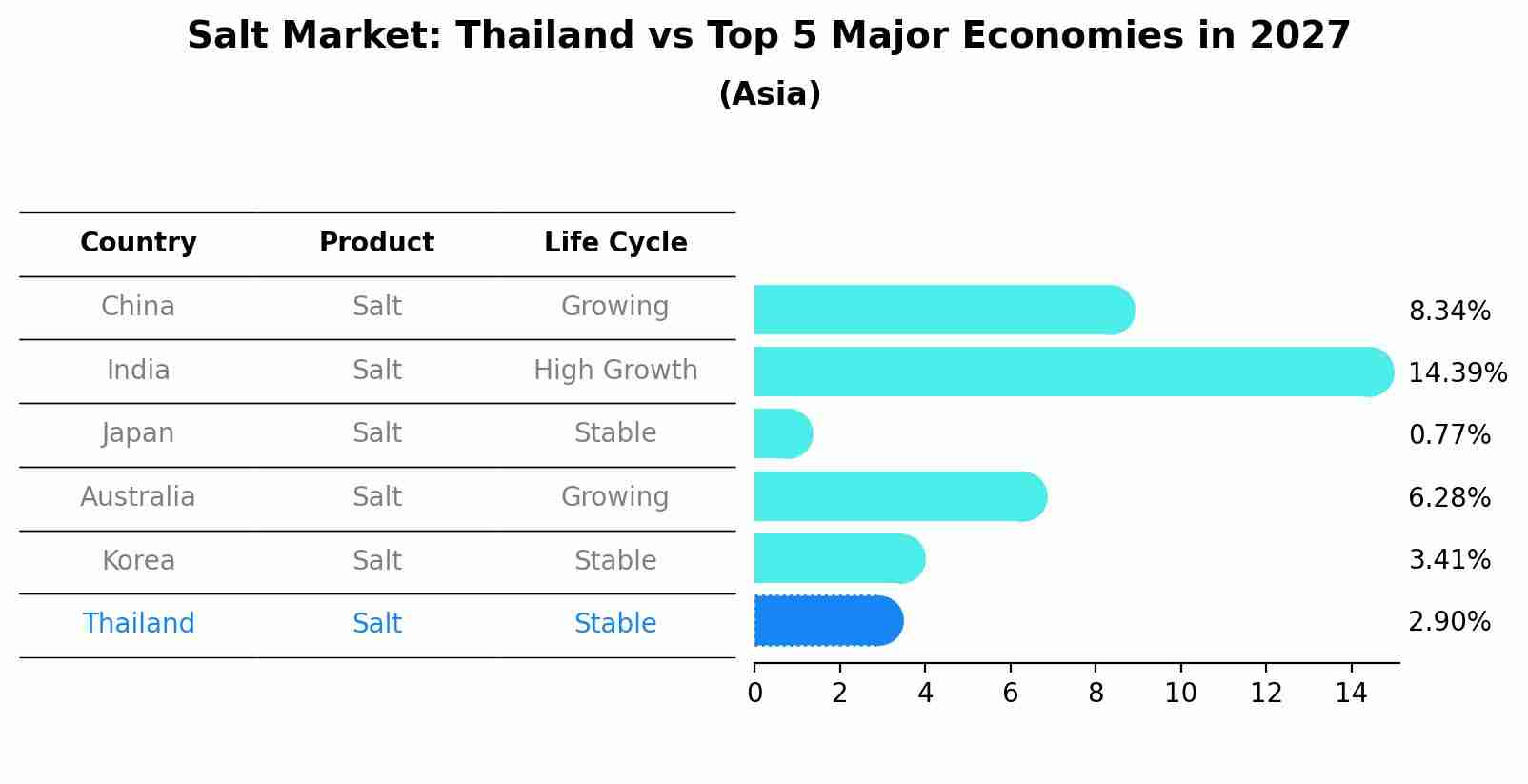Thailand Salt Market (2025-2031) Outlook | Trends, Forecast, Analysis, Share, Value, Growth, Revenue, Companies, Industry & Size
| Product Code: ETC074504 | Publication Date: Jul 2023 | Updated Date: Apr 2025 | Product Type: Report | |
| Publisher: 6Wresearch | No. of Pages: 70 | No. of Figures: 35 | No. of Tables: 5 | |
Thailand Salt Market Size Growth Rate
The Thailand Salt Market is projected to witness mixed growth rate patterns during 2025 to 2029. Commencing at 3.30% in 2025, growth builds up to 6.16% by 2029.

Salt Market: Thailand vs Top 5 Major Economies in 2027 (Asia)
By 2027, the Salt market in Thailand is anticipated to reach a growth rate of 2.90%, as part of an increasingly competitive Asia region, where China remains at the forefront, supported by India, Japan, Australia and South Korea, driving innovations and market adoption across sectors.

Thailand Salt Market Synopsis
The salt market in Thailand is an essential segment of the country`s food and chemical industries. Salt, primarily sodium chloride, is a crucial ingredient used in various food processing, culinary applications, and chemical production. In Thailand, the market for salt is driven by factors such as the growing demand for processed and packaged food products, the expanding chemical industry, and the use of salt for traditional culinary purposes. Additionally, the country`s coastal geography and salt production facilities contribute to a steady supply of salt, supporting various industries` requirements.
Market Drivers
Several factors contribute to the growth of the salt market in Thailand. Firstly, the food processing industry is a major driver, with salt being a critical ingredient for flavoring, preserving, and enhancing the taste of various processed and packaged food products. As the demand for convenience foods increases, so does the need for salt in the food manufacturing sector. Additionally, the chemical industry relies on salt for various chemical processes, such as the production of chlorine and caustic soda. The country`s expanding chemical sector further boosts the demand for industrial salt. Moreover, salt plays a vital role in Thailand culinary traditions, with its usage in various Thailand dishes, contributing to the domestic market`s consistent demand.
Challenges of the Market
While the Thailand salt market has experienced positive growth, it is not without its challenges. One of the significant challenges faced by the industry is the volatility of salt prices in the international market. Fluctuations in global salt prices can impact domestic prices, affecting profit margins for both producers and consumers. Furthermore, environmental concerns related to salt production and its potential impact on local ecosystems have come to the forefront, prompting the industry to adopt more sustainable practices. Additionally, the competition from imported salt products in the domestic market poses a challenge for local salt manufacturers.
Covid-19 Impact on the Market
The outbreak of the Covid-19 pandemic in 2025 had a notable impact on the Thailand salt market. As the country implemented lockdown measures and restrictions on movement, the foodservice sector experienced a significant decline in demand. With restaurants, hotels, and catering businesses temporarily shut down or operating at limited capacities, the demand for salt from this sector dwindled. However, the surge in home cooking and increased consumption of packaged and processed foods during the pandemic helped partially offset this decline. Moreover, disruptions in the supply chain and logistical challenges posed additional hurdles for salt manufacturers and distributors.
Key Highlights of the Report:
- Thailand Salt Market Outlook
- Market Size of Thailand Salt Market, 2024
- Forecast of Thailand Salt Market, 2031
- Historical Data and Forecast of Thailand Salt Revenues & Volume for the Period 2021-2031
- Thailand Salt Market Trend Evolution
- Thailand Salt Market Drivers and Challenges
- Thailand Salt Price Trends
- Thailand Salt Porter's Five Forces
- Thailand Salt Industry Life Cycle
- Historical Data and Forecast of Thailand Salt Market Revenues & Volume By Type for the Period 2021-2031
- Historical Data and Forecast of Thailand Salt Market Revenues & Volume By Rock Salt for the Period 2021-2031
- Historical Data and Forecast of Thailand Salt Market Revenues & Volume By Brine for the Period 2021-2031
- Historical Data and Forecast of Thailand Salt Market Revenues & Volume By Solar Salt for the Period 2021-2031
- Historical Data and Forecast of Thailand Salt Market Revenues & Volume By Others for the Period 2021-2031
- Historical Data and Forecast of Thailand Salt Market Revenues & Volume By Applications for the Period 2021-2031
- Historical Data and Forecast of Thailand Salt Market Revenues & Volume By Chemical Processing for the Period 2021-2031
- Historical Data and Forecast of Thailand Salt Market Revenues & Volume By Road De-icing for the Period 2021-2031
- Historical Data and Forecast of Thailand Salt Market Revenues & Volume By Food Processing for the Period 2021-2031
- Historical Data and Forecast of Thailand Salt Market Revenues & Volume By Others for the Period 2021-2031
- Thailand Salt Import Export Trade Statistics
- Market Opportunity Assessment By Type
- Market Opportunity Assessment By Applications
- Thailand Salt Top Companies Market Share
- Thailand Salt Competitive Benchmarking By Technical and Operational Parameters
- Thailand Salt Company Profiles
- Thailand Salt Key Strategic Recommendations
Frequently Asked Questions About the Market Study (FAQs):
1 Executive Summary |
2 Introduction |
2.1 Key Highlights of the Report |
2.2 Report Description |
2.3 Market Scope & Segmentation |
2.4 Research Methodology |
2.5 Assumptions |
3 Thailand Salt Market Overview |
3.1 Thailand Country Macro Economic Indicators |
3.2 Thailand Salt Market Revenues & Volume, 2021 & 2031F |
3.3 Thailand Salt Market - Industry Life Cycle |
3.4 Thailand Salt Market - Porter's Five Forces |
3.5 Thailand Salt Market Revenues & Volume Share, By Type, 2021 & 2031F |
3.6 Thailand Salt Market Revenues & Volume Share, By Applications, 2021 & 2031F |
4 Thailand Salt Market Dynamics |
4.1 Impact Analysis |
4.2 Market Drivers |
4.3 Market Restraints |
5 Thailand Salt Market Trends |
6 Thailand Salt Market, By Types |
6.1 Thailand Salt Market, By Type |
6.1.1 Overview and Analysis |
6.1.2 Thailand Salt Market Revenues & Volume, By Type, 2021-2031F |
6.1.3 Thailand Salt Market Revenues & Volume, By Rock Salt, 2021-2031F |
6.1.4 Thailand Salt Market Revenues & Volume, By Brine , 2021-2031F |
6.1.5 Thailand Salt Market Revenues & Volume, By Solar Salt, 2021-2031F |
6.1.6 Thailand Salt Market Revenues & Volume, By Others, 2021-2031F |
6.2 Thailand Salt Market, By Applications |
6.2.1 Overview and Analysis |
6.2.2 Thailand Salt Market Revenues & Volume, By Chemical Processing, 2021-2031F |
6.2.3 Thailand Salt Market Revenues & Volume, By Road De-icing, 2021-2031F |
6.2.4 Thailand Salt Market Revenues & Volume, By Food Processing, 2021-2031F |
6.2.5 Thailand Salt Market Revenues & Volume, By Others, 2021-2031F |
7 Thailand Salt Market Import-Export Trade Statistics |
7.1 Thailand Salt Market Export to Major Countries |
7.2 Thailand Salt Market Imports from Major Countries |
8 Thailand Salt Market Key Performance Indicators |
9 Thailand Salt Market - Opportunity Assessment |
9.1 Thailand Salt Market Opportunity Assessment, By Type, 2021 & 2031F |
9.2 Thailand Salt Market Opportunity Assessment, By Applications, 2021 & 2031F |
10 Thailand Salt Market - Competitive Landscape |
10.1 Thailand Salt Market Revenue Share, By Companies, 2024 |
10.2 Thailand Salt Market Competitive Benchmarking, By Operating and Technical Parameters |
11 Company Profiles |
12 Recommendations |
13 Disclaimer |
- Single User License$ 1,995
- Department License$ 2,400
- Site License$ 3,120
- Global License$ 3,795
Search
Related Reports
- UAE Building Thermal Insulation Market Outlook (2025-2031) | Revenue, Companies, Share, Trends, Growth, Size, Forecast, Industry, Analysis & Value
- Portugal Electronic Document Management Market (2025-2031) | Strategy, Consumer Insights, Analysis, Investment Trends, Opportunities, Growth, Size, Share, Industry, Revenue, Segments, Value, Segmentation, Supply, Forecast, Restraints, Outlook, Competition, Drivers, Trends, Demand, Pricing Analysis, Competitive, Strategic Insights, Companies, Challenges
- France Electronic Document Management Market (2025-2031) | Strategy, Consumer Insights, Analysis, Investment Trends, Opportunities, Growth, Size, Share, Industry, Revenue, Segments, Value, Segmentation, Supply, Forecast, Restraints, Outlook, Competition, Drivers, Trends, Demand, Pricing Analysis, Competitive, Strategic Insights, Companies, Challenges
- Portugal Occupational Health & Safety Services Market (2025-2031) | Strategy, Consumer Insights, Analysis, Investment Trends, Opportunities, Growth, Size, Share, Industry, Revenue, Segments, Value, Segmentation, Supply, Forecast, Restraints, Outlook, Competition, Drivers, Trends, Demand, Pricing Analysis, Competitive, Strategic Insights, Companies, Challenges
- Netherlands Occupational Health and Safety Services Market (2025-2031) | Strategy, Consumer Insights, Analysis, Investment Trends, Opportunities, Growth, Size, Share, Industry, Revenue, Segments, Value, Segmentation, Supply, Forecast, Restraints, Outlook, Competition, Drivers, Trends, Demand, Pricing Analysis, Competitive, Strategic Insights, Companies, Challenges
- Belgium and Luxembourg Facility Management Market (2025-2031) | Strategy, Consumer Insights, Analysis, Investment Trends, Opportunities, Growth, Size, Share, Industry, Revenue, Segments, Value, Segmentation, Supply, Forecast, Restraints, Outlook, Competition, Drivers, Trends, Demand, Pricing Analysis, Competitive, Strategic Insights, Companies, Challenges
- Russia Women Intimate Apparel Market (2025-2031) | Strategy, Consumer Insights, Analysis, Investment Trends, Opportunities, Growth, Size, Share, Industry, Revenue, Segments, Value, Segmentation, Supply, Forecast, Restraints, Outlook, Competition, Drivers, Trends, Demand, Pricing Analysis, Competitive, Strategic Insights, Companies, Challenges
- Africa Chocolate Market (2025-2031) | Size, Share, Trends, Growth, Revenue, Analysis, Forecast, industry & Outlook
- Global Hydroxychloroquine And Chloroquine Market (2025-2031) | Industry, Trends, Size, Outlook, Growth, Value, Companies, Revenue, Analysis, Share, Forecast
- Saudi Arabia Plant Maintenance Market (2025-2031) | Industry, Size, Growth, Revenue, Value, Companies, Forecast, Analysis, Share & Trends
Industry Events and Analyst Meet
Our Clients
Whitepaper
- Middle East & Africa Commercial Security Market Click here to view more.
- Middle East & Africa Fire Safety Systems & Equipment Market Click here to view more.
- GCC Drone Market Click here to view more.
- Middle East Lighting Fixture Market Click here to view more.
- GCC Physical & Perimeter Security Market Click here to view more.
6WResearch In News
- Doha a strategic location for EV manufacturing hub: IPA Qatar
- Demand for luxury TVs surging in the GCC, says Samsung
- Empowering Growth: The Thriving Journey of Bangladesh’s Cable Industry
- Demand for luxury TVs surging in the GCC, says Samsung
- Video call with a traditional healer? Once unthinkable, it’s now common in South Africa
- Intelligent Buildings To Smooth GCC’s Path To Net Zero













